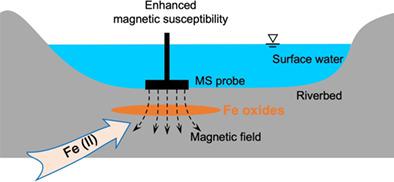当前位置:
X-MOL 学术
›
Hydrol. Process.
›
论文详情
Our official English website, www.x-mol.net, welcomes your feedback! (Note: you will need to create a separate account there.)
Evaluation of riverbed magnetic susceptibility for mapping biogeochemical hot spots in groundwater-impacted rivers
Hydrological Processes ( IF 3.2 ) Pub Date : 2021-04-20 , DOI: 10.1002/hyp.14184 Chen Wang 1 , Martin A. Briggs 2 , Frederick D. Day‐Lewis 2 , Lee D. Slater 1
Hydrological Processes ( IF 3.2 ) Pub Date : 2021-04-20 , DOI: 10.1002/hyp.14184 Chen Wang 1 , Martin A. Briggs 2 , Frederick D. Day‐Lewis 2 , Lee D. Slater 1
Affiliation

|
Redox hot spots occurring as metal-rich anoxic groundwater discharges through oxic wetland and river sediments commonly result in the formation of iron (Fe) oxide precipitates. These redox-sensitive precipitates influence the release of nutrients and metals to surface water and can act as ‘contaminant sponges’ by absorbing toxic compounds. We explore the feasibility of a non-invasive, high-resolution magnetic susceptibility (MS) technique to efficiently map the spatial variations of magnetic Fe oxide precipitates in the shallow bed of three rivers impacted by anoxic groundwater discharge. Laboratory analyses on Mashpee River (MA, USA) sediments demonstrate the sensitivity of MS to sediment Fe concentrations. Field surveys in the Mashpee and Quashnet rivers (MA, USA) reveal several discrete high MS zones, which are associated with likely anoxic groundwater discharge as evaluated by riverbed temperature, vertical head gradient, and groundwater chemistry measurements. In the East River (CO, USA), widespread cobbles/rocks exhibit high background MS from geological ferrimagnetic minerals, thereby obscuring the relatively small enhancement of MS from groundwater induced Fe oxide precipitates. Our study suggests that, in settings with low geological sources of magnetic minerals such as lowland rivers and wetlands, MS may serve as a complementary tool to temperature methods for efficiently mapping Fe oxide accumulation zones due to anoxic groundwater discharges that may function as biogeochemical hot spots and water quality control points in gaining systems.
中文翻译:

绘制地下水影响河流中生物地球化学热点的河床磁化率评估
当富金属的缺氧地下水通过有氧湿地和河流沉积物排放时,氧化还原热点通常会导致形成铁(Fe)氧化物沉淀。这些对氧化还原敏感的沉淀物会影响营养物质和金属向地表水中的释放,并通过吸收有毒化合物而充当“污染物海绵”。我们探索无创,高分辨率磁化率(MS)技术的可行性,以有效地绘制受缺氧地下水排放影响的三河的浅层中磁性Fe氧化物沉淀的空间变化。对马斯皮河(美国马萨诸塞州)沉积物的实验室分析表明,MS对沉积物中铁的浓度敏感。在Mashpee和Quashnet河流(美国马萨诸塞州)进行的实地调查显示,有几个离散的高MS区,通过河床温度,垂直水头坡度和地下水化学测量评估,它们与可能的缺氧地下水排放有关。在东河(美国科罗拉多州),广泛的鹅卵石/岩石显示出地质亚铁磁性矿物的高背景MS,从而掩盖了地下水诱导的Fe氧化物沉淀中MS相对较小的增强。我们的研究表明,在地质矿物资源低的地方(例如低地河流和湿地),MS可以作为温度方法的补充工具,以有效地绘制由于缺氧的地下水排放而可能形成生物地球化学热点的Fe氧化物聚集区的图。增益系统中的水质控制点。和地下水化学测量。在东河(美国科罗拉多州),广泛的鹅卵石/岩石显示出地质亚铁磁性矿物的高背景MS,从而掩盖了地下水诱导的Fe氧化物沉淀中MS相对较小的增强。我们的研究表明,在地质矿物资源低的地方(例如低地河流和湿地),MS可以作为温度方法的补充工具,以有效地绘制由于缺氧的地下水排放而可能形成生物地球化学热点的Fe氧化物聚集区的图。增益系统中的水质控制点。和地下水化学测量。在东河(美国科罗拉多州),广泛的鹅卵石/岩石显示出地质亚铁磁性矿物的高背景MS,从而掩盖了地下水诱导的Fe氧化物沉淀中MS相对较小的增强。我们的研究表明,在地质矿物资源低的地方(例如低地河流和湿地),MS可以作为温度方法的补充工具,以有效地绘制由于缺氧的地下水排放而可能形成生物地球化学热点的Fe氧化物聚集区的图。增益系统中的水质控制点。从而掩盖了地下水引起的Fe氧化物沉淀中MS相对较小的增强。我们的研究表明,在地质矿物资源低的地方(例如低地河流和湿地),MS可以作为温度方法的补充工具,以有效地绘制由于缺氧的地下水排放而可能形成生物地球化学热点的Fe氧化物聚集区的图。增益系统中的水质控制点。从而掩盖了地下水引起的Fe氧化物沉淀中MS相对较小的增强。我们的研究表明,在地质矿物资源低的地方(例如低地河流和湿地),MS可以作为温度方法的补充工具,以有效地绘制由于缺氧的地下水排放而可能形成生物地球化学热点的Fe氧化物聚集区的图。增益系统中的水质控制点。
更新日期:2021-05-22
中文翻译:

绘制地下水影响河流中生物地球化学热点的河床磁化率评估
当富金属的缺氧地下水通过有氧湿地和河流沉积物排放时,氧化还原热点通常会导致形成铁(Fe)氧化物沉淀。这些对氧化还原敏感的沉淀物会影响营养物质和金属向地表水中的释放,并通过吸收有毒化合物而充当“污染物海绵”。我们探索无创,高分辨率磁化率(MS)技术的可行性,以有效地绘制受缺氧地下水排放影响的三河的浅层中磁性Fe氧化物沉淀的空间变化。对马斯皮河(美国马萨诸塞州)沉积物的实验室分析表明,MS对沉积物中铁的浓度敏感。在Mashpee和Quashnet河流(美国马萨诸塞州)进行的实地调查显示,有几个离散的高MS区,通过河床温度,垂直水头坡度和地下水化学测量评估,它们与可能的缺氧地下水排放有关。在东河(美国科罗拉多州),广泛的鹅卵石/岩石显示出地质亚铁磁性矿物的高背景MS,从而掩盖了地下水诱导的Fe氧化物沉淀中MS相对较小的增强。我们的研究表明,在地质矿物资源低的地方(例如低地河流和湿地),MS可以作为温度方法的补充工具,以有效地绘制由于缺氧的地下水排放而可能形成生物地球化学热点的Fe氧化物聚集区的图。增益系统中的水质控制点。和地下水化学测量。在东河(美国科罗拉多州),广泛的鹅卵石/岩石显示出地质亚铁磁性矿物的高背景MS,从而掩盖了地下水诱导的Fe氧化物沉淀中MS相对较小的增强。我们的研究表明,在地质矿物资源低的地方(例如低地河流和湿地),MS可以作为温度方法的补充工具,以有效地绘制由于缺氧的地下水排放而可能形成生物地球化学热点的Fe氧化物聚集区的图。增益系统中的水质控制点。和地下水化学测量。在东河(美国科罗拉多州),广泛的鹅卵石/岩石显示出地质亚铁磁性矿物的高背景MS,从而掩盖了地下水诱导的Fe氧化物沉淀中MS相对较小的增强。我们的研究表明,在地质矿物资源低的地方(例如低地河流和湿地),MS可以作为温度方法的补充工具,以有效地绘制由于缺氧的地下水排放而可能形成生物地球化学热点的Fe氧化物聚集区的图。增益系统中的水质控制点。从而掩盖了地下水引起的Fe氧化物沉淀中MS相对较小的增强。我们的研究表明,在地质矿物资源低的地方(例如低地河流和湿地),MS可以作为温度方法的补充工具,以有效地绘制由于缺氧的地下水排放而可能形成生物地球化学热点的Fe氧化物聚集区的图。增益系统中的水质控制点。从而掩盖了地下水引起的Fe氧化物沉淀中MS相对较小的增强。我们的研究表明,在地质矿物资源低的地方(例如低地河流和湿地),MS可以作为温度方法的补充工具,以有效地绘制由于缺氧的地下水排放而可能形成生物地球化学热点的Fe氧化物聚集区的图。增益系统中的水质控制点。



























 京公网安备 11010802027423号
京公网安备 11010802027423号